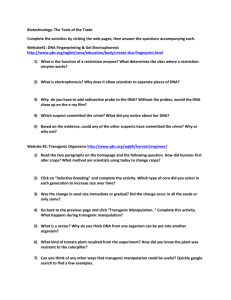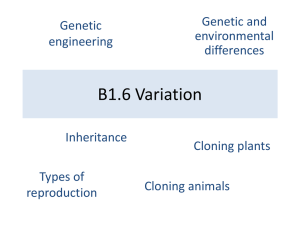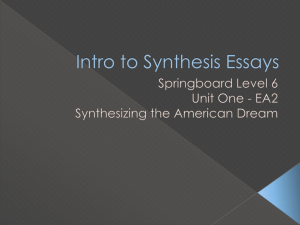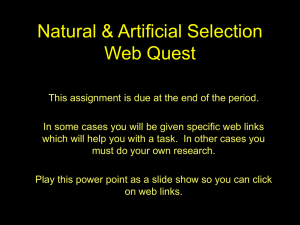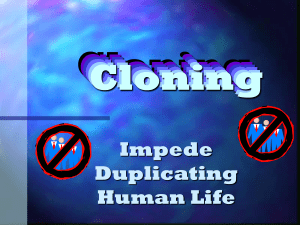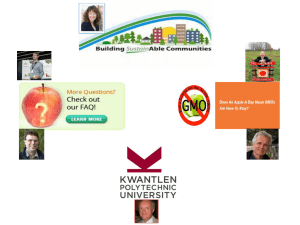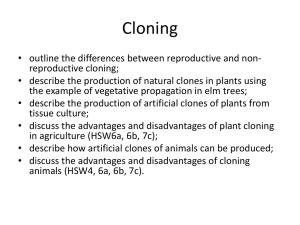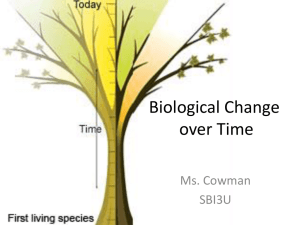biology assessment
advertisement
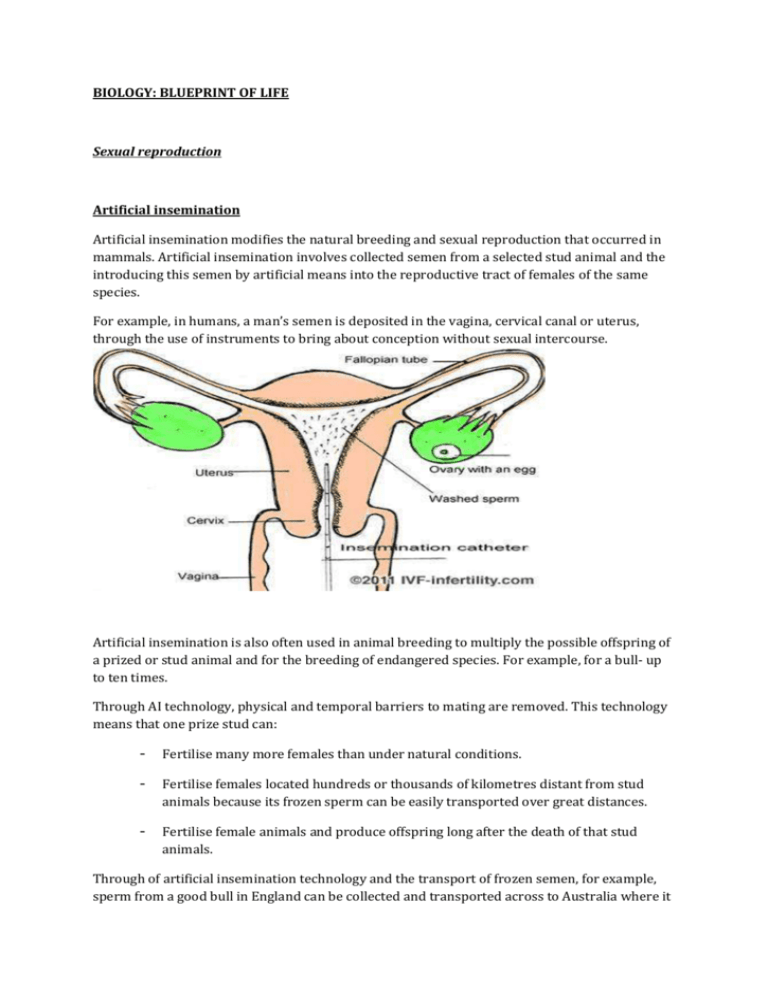
BIOLOGY: BLUEPRINT OF LIFE Sexual reproduction Artificial insemination Artificial insemination modifies the natural breeding and sexual reproduction that occurred in mammals. Artificial insemination involves collected semen from a selected stud animal and the introducing this semen by artificial means into the reproductive tract of females of the same species. For example, in humans, a man’s semen is deposited in the vagina, cervical canal or uterus, through the use of instruments to bring about conception without sexual intercourse. Artificial insemination is also often used in animal breeding to multiply the possible offspring of a prized or stud animal and for the breeding of endangered species. For example, for a bull- up to ten times. Through AI technology, physical and temporal barriers to mating are removed. This technology means that one prize stud can: - Fertilise many more females than under natural conditions. - Fertilise females located hundreds or thousands of kilometres distant from stud animals because its frozen sperm can be easily transported over great distances. - Fertilise female animals and produce offspring long after the death of that stud animals. Through of artificial insemination technology and the transport of frozen semen, for example, sperm from a good bull in England can be collected and transported across to Australia where it can used to artificially inseminate a chosen cow, the genetic influence of a small number of stud animals has been greatly extended over time and space. This influence has affected the genetic composition of the herds concerned. Overall, the widespread use of artificial insemination in animal breeding, using a limited number of stud animals can result in a loss of genetic variation from the genetic composition of that species in a population. It creates an imbalance of sexes in the population as couples/breeder can determine the gender of the unborn, prior to fertilization. It also reduces the chances of random crosses in the population and thus reduces genetic variability within the population. Artificial pollination Artificial pollination is the process which involves removing the stamens of a flower and dusting the pollen onto the stigma of the same flower (self-pollination) and another flower (crosspollination). The process of artificial pollination involves: Removal or unripe stamens from the plant to be fertilised Protection of the stigma of the selected female plant from stray pollen Collection of pollen to be used in the artificial pollination Transfer of the donor pollen onto the stigma of the female plant Artificial pollination reduces genetic diversity due to plants obtaining almost similar characteristics; thus creating new hybrid species, and so alters the genetic composition of a population. This usually results in a reduction of plant species biodiversity, because unwanted characteristics are ‘bred out’. Cloning Cloning is the process of making genetically identical copies of an organism without using sexual reproduction. There are three types of cloning: 1. Reproductive cloning – which involves creating a genetically identical, fully developed organism using a cell, or a few cells from another mature organism. This whole organism cloning is a form of asexual reproduction and so it is considered to be a reproductive technology. 2. Therapeutic cloning – which involves using cells from an individual to produce a cloned embryo, which is then used as a source of embryonic stem cells to replace degenerating adult tissues or to repair damage. The purpose of therapeutic cloning is not to produce a new animal or plat, but to provide a source of cells that can be used to repair adult tissue that has been damaged. 3. Gene cloning – occurs at a cellular level and involves producing identical copies of a gene. It is an important step in the process of genetic engineering. Cloning involves methods of asexual reproduction in which genetic information of the new organism comes from one ‘parent’ cell only. The cloning of mammals involves: - obtaining the nucleus from a somatic (body) cell of an adult animal – this is the ‘donor’ nucleus Removing the nucleus from an unfertilised effect cell, typically of the same species – this is the enucleated egg cell. Transferring the donor nucleus into the enucleated egg cell. Culturing the egg cell and donor nucleus until embryonic development begins. Transferring the developing embryo into the uterus or a surrogate animal where it completes development. The genetic information in the cloned animal comes from the nucleus of the adult body cell, and so the genotype of the cloned animal is determined by the donor nucleus and not by the egg in which the nucleus is transferred. However the success rate for initiating development of the egg cell after transfer of the donor nucleus is low. Cloning in plants Cloning of plants occurs both naturally and artificially. Natural cloning occurs through runners and suckers. Artificial cloning of plants involves cuttings and the culturing of a piece of adult plant. As this piece grows, it can be further subdivided so that a large number of genetically identical plants can be produced from the original piece. Overall Cloning produces populations of animals that are genetically identical to each other. The advantage of this is that characteristics can be precisely controlled and organisms can be produced in short periods of time, however the population is less likely to survive sudden environmental changes. Also, all cloned organisms within a population are genetically identical so every organism is susceptible to the same diseases which could wipe out the whole population. Methodology used in cloning (DOLLY the sheep) Reproductive cloning is known as somatic cell nuclear transfer [SCNT]. Each time a mammal is cloned; the process (SCNT) involves three animals: one that donates the nucleus, one that acts as an egg donor and one that plays the role of surrogate mother. Ian Wilmut and his team used the method of SCNT to create Dolly the sheep: 1. 2. Cells were taken from the udder (mammary glands) of a six year old ewe. They were starved of nutrients to stop them dividing. The nucleus was removed from an unfertilised egg, a process called nucleation, of another sheep. The scientists made sure the rest of the cell (the cytoplasmic contents and membrane) was in good working order. An udder cell from sheep 1 was injected into the enucleated egg of sheep 2. The two cells were then zapped with electricity, which cause the cells to fuse together and the now fertilised egg cell was allowed to undergo normal growth and development by the process of mitosis. As the cells continued to divide, the embryo was implanted into the uterus of a third sheep. The embryo continued to grow and was born as a genetic identical twin to the first sheep – the original sheep that donated from its mammary gland Reproductive technologies, such as cloning, and the engineering of transgenic species have the potential to both increase and decrease genetic diversity. By moving genes from species to species, the genetic diversity is being increased. Crops, such as rice, have been genetically engineered to suit a particular climate and topography, making then resistant to herbicides and pesticides commonly used in a particular region. Transgenic animals present greater problems with lower success rates so far. One important use is seen to be the preservation of numbers of endangered species. The first cloned endangered mammal was a guar (an endangered wild ox from SE Asia), but unfortunately it did not survive. It is hoped that reproductive technologies such as cloning and sperm and embryo banks can be used to preserve stocks of threatened species. Transgenic species A transgenic organism is one whose normal genome has been altered by introducing a gene from another species (transgene) into it in such a way that the organism can pass on this transgene to its offspring during reproduction. Two examples of a transgenic species are: 1. Genetically engineered salmon, which contain the hormone BGH (bovine growth hormone). This makes the salmon much bigger for farming and are offered no chance to escape into the wild as they could damage an ecosystem. 2. Genetically engineered, Vaccine producing bananas: genetically engineered bananas that contain a vaccine. Bananas provide an easy means for delivering a vaccine (especially to children) without the need for a medical professional that is trained in giving shots. Processes Used to Produce Transgenic Species: The steps in producing a transgenic species are usually like this: A useful gene, and the chromosome it is on, is identified The gene is ‘isolated’ or cut-out of its DNA strand Separate DNA sequences for regulation may have to be added to ensure the gene will work The gene is inserted into the cell of another organism. Sometimes a vector is used to do this. A vector is a carrier of a substance from one species to another Techniques Used to Produce Transgenic Species: Isolating Genes: Once a useful gene is identified, it has to be isolated by ‘cutting’ it out of its DNA strand. Special enzymes, called restriction enzymes are used. More than 800 types are known. They cut DNA by breaking the hydrogen bonds in a triplet – the ends are called “sticky ends” Making Recombinant DNA: The DNA strands from 2 organisms are cut using the same enzyme, the sticky ends will match. When they are mixed, the new gene will match with the DNA strands, and link up. This is called ANNEALING. DNA ligases are added to strengthen the bonds. Making Transgenes: An isolated gene cannot function if it is transferred alone. It has to be transferred with a promoter sequence attached to ensure it works. Inserting Genes into Bacteria: Most bacteria contain small, circular pieces of DNA called plasmids Plasmids can be used as vectors or carriers to transfer transgenes into bacteria Reasons for Using These Processes: These processes enable scientists to combine the qualities of different organisms Transgenic species are being developed to: Increase the resistance of plants or animals to diseases, pests or extreme environmental conditions For medicines and vaccines and to study human diseases To improve productivity of crops, pastures and animals To improve the quality of food and efficiency of food processing Genetic engineering arising transgenic species is a huge gamble within our world. First of all, living organisms evolved into the ‘immune’ specie they are today, where they have become adapted to their specific environment as well as their behaviours. And introducing transgenic species may change the way all types of ecosystems function, for example salmon with the bovine growth hormone may cause breeding defects wiping out a whole population in one go, which can also be said for terrestrial organisms such as cows. However, transgenic species bring opportunities in order for us to obtain what we have now before we lose it, for example it is expected that we will run out of bananas in 10 year, yes 10 years. We can incorporate this new technology in order for us to try and obtain our flora as well as fauna from extinction. References Internet / websites - Harvard citation style - Guides at University of Western Australia. 2015. Internet / websites - Harvard citation style - Guides at University of Western Australia. [ONLINE] Available at: http://guides.is.uwa.edu.au/content.php?pid=43218&sid=328596. [Accessed 11 May 2015]. Transgenic Organisms | Genetics GenerationGenetics Generation . 2015. Transgenic Organisms | Genetics GenerationGenetics Generation . [ONLINE] Available at: http://knowgenetics.org/transgenic-organisms/. [Accessed 11 May 2015].http://www.hsc.csu.edu.au/biology/core/blueprint/2664/BIO935NET.htm Actionbioscience | Transgenic Animals: Their Benefits To Human Welfare. 2015. Actionbioscience | Transgenic Animals: Their Benefits To Human Welfare. [ONLINE] Available at: http://www.actionbioscience.org/biotechnology/margawati.html. [Accessed 11 May 2015].http://www.actionbioscience.org/biotechnology/glenn.html 2. Blueprint Of Life | hscbiology. 2015. 2. Blueprint Of Life | hscbiology. [ONLINE] Available at: https://hscbiology.wordpress.com/blueprint-of-life/. [Accessed 11 May 2015].http://www.infoplease.com/encyclopedia/science/artificial-insemination.html . 2015. . [ONLINE] Available at: http://www.lifeandexperiences.com/wpcontent/uploads/2015/01/IVF.jpg. [Accessed 11 May 2015]. R.B. Knox, 1994. Biology. Edition. McGraw-Hill Australia. Don Rittner, 2004. Encyclopedia of Biology (Science Encyclopedia). Edition. Facts on File. Eileen Kennedy Peter Aubusson, 2001. Biology in Context: the Spectrum of Life. Edition. Oxford Uni. Press.. HSC Biology Topic 2.2005. Blueprint of life.Keep it simple science..
